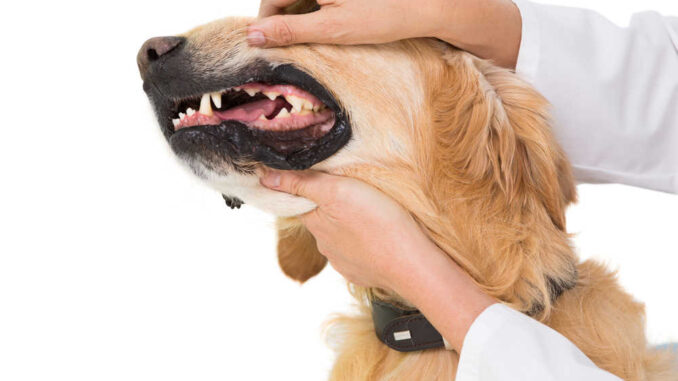
This article was updated on October 17th, 2023

If you’ve noticed a new lump, bump or growth on your dog’s lips, you’re likely jumping to all sorts of conclusions about what it could be. As a veterinarian working in a busy clinic, I see lip lumps and bumps on a weekly basis. In this article, I will discuss the top causes & what to do.
5 frequent causes of bumps on dog lips (with pictures)
Let’s take a look at all of the potential contenders when our dog develops a new lip lump:
1. Papillomas / warts
A papilloma (wart) is caused by the papillomavirus and generally affect younger dogs. While we can see papillomas anywhere, most appear on or in the mouth and lips. Papillomas are usually light-colored: pale pink or white, and look like ‘little brains.’
They are not always well attached to the skin and sometimes bleed when they hit something. Most young dogs are unaware that they have them and are not bothered by them.
Pictures of papillomas on dog lips:
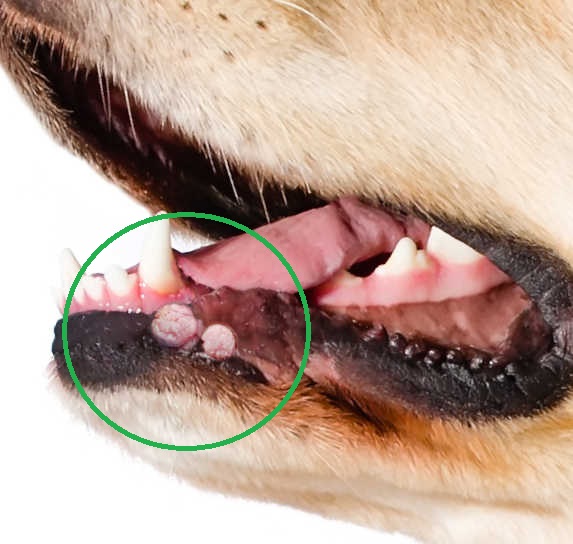
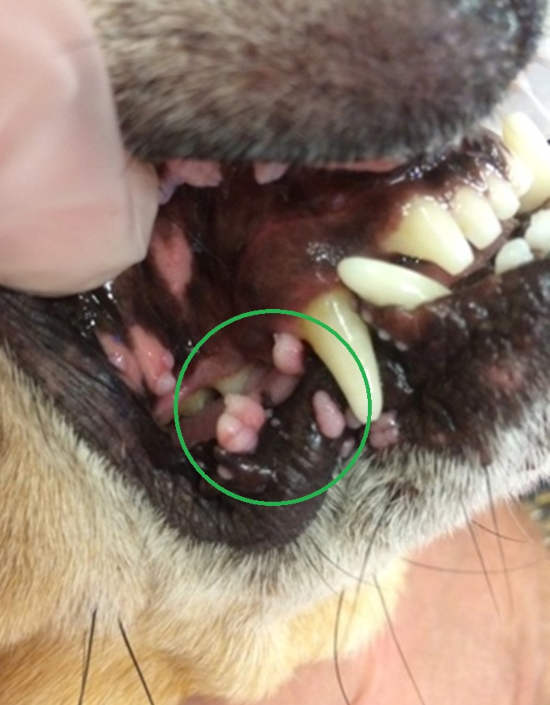
Warts come in many shapes and colors. The dog on the picture below has a small black wart that presents as a smooth and shiny circular lesion, raised and situated just over her lip (similar bumps could also be cysts or tumors).

Vets will be happy to diagnose a papilloma based on the appearance, and we usually take a ‘wait and see’ approach, as the papilloma could disappear without treatment in just a few months.
View more pictures of dog warts/papillomas.
2. Skin tags
When dogs enter their teenage years, it is not unusual for them to start developing skin tags or ‘old age warts.’ These can appear anywhere on the body, including near the lips. These skin tags can hang on a ‘stalk’ or may be more firmly attached to the body. Most skin tags are a fleshy color, but they can have pigment too.
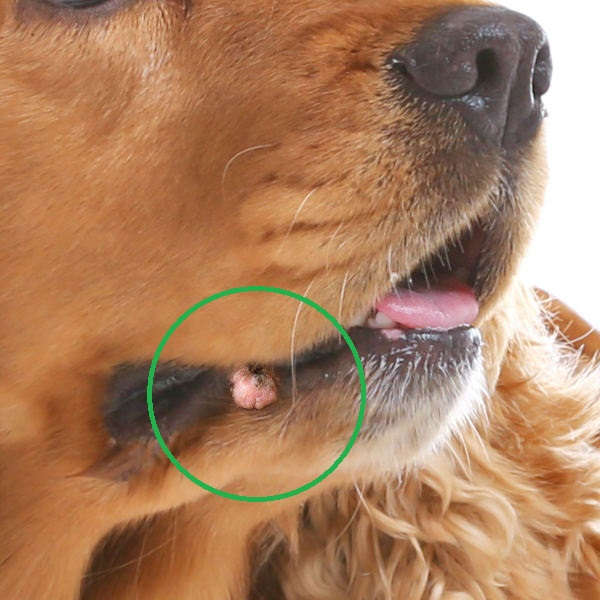
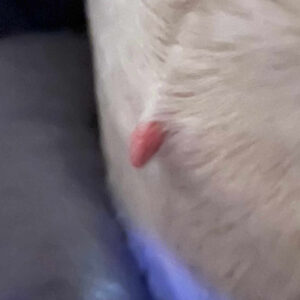
Your veterinarian may be happy to monitor the growth, or they might suggest surgical removal. A vet is more likely to want to remove the skin tag if it is affecting your dog.
Learn more about Skin Tags.
3. Tumors
In some cases, a lip lump will turn out to be a cancerous tumor. As a rule of thumb, cancers will be fast-growing, and the skin surface can ulcerate and bleed. It is not uncommon for tumors, especially large ones, to develop infections on the surface.
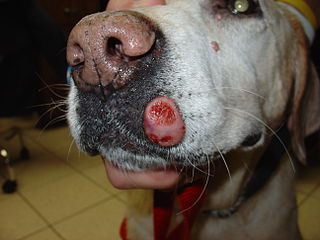
(Photo: Joel Mills Wikimedia Commons)
Even if a dog has a relatively large tumor, they will not necessarily act any differently. Indeed, even malignant cancers don’t tend to cause pain. A suspected tumor will be sampled by your veterinarian, either by taking an FNA or biopsy, to confirm diagnosis.
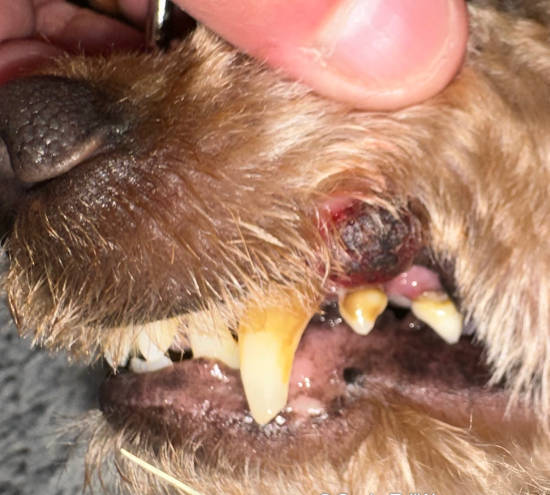
“Unfortunately, there is no reliable way to determine if a lip mass is benign or malignant just by looking at it. A biopsy or fine needle aspirate is a must.”
Treatment would depend on the type of tumor and the tumor grade. Most malignant growths should be removed as soon as possible. In some cases, dogs would also undergo chemotherapy.
Learn more about Tumors Often Found on Lips.
4. Pustules
A blister filled with pus can appear on or near the lips, and you may find your dog is itchy, rubbing, and scratching at the lesion. These pustules can occur alongside allergic dermatitis and canine acne.
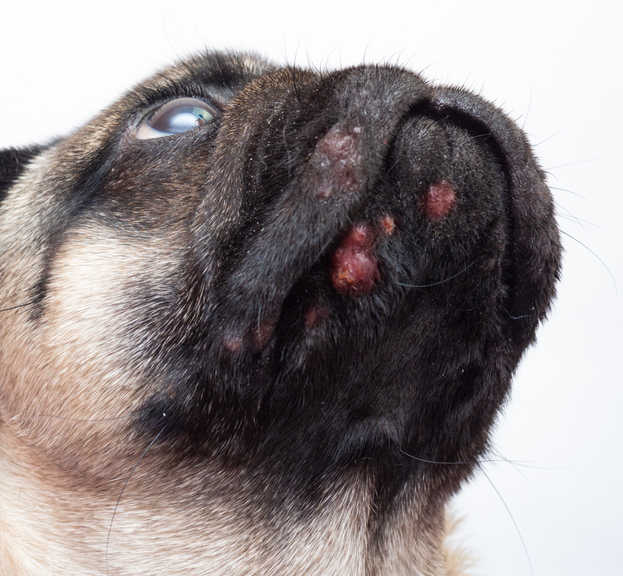
For most dogs, treating the underlying skin disease will ensure that the pustules resolve. This can include antibiotics and medicated washes containing Chlorhexidine. If your dog does have a food or environmental allergy, we’d ideally identify what they are reacting to and try to avoid it where possible. Click here to view more pictures of dog acne with info from our veterinarians.
5. A recent insect bite or injury
Of course, there may be a simple explanation when we find a new lump, like a wasp sting, insect bite or a scab after an injury. These sorts of bumps or growths should only last a few days and would only be expected to cause mild discomfort. This lip bump below could be the result of a recent insect bite or injury:
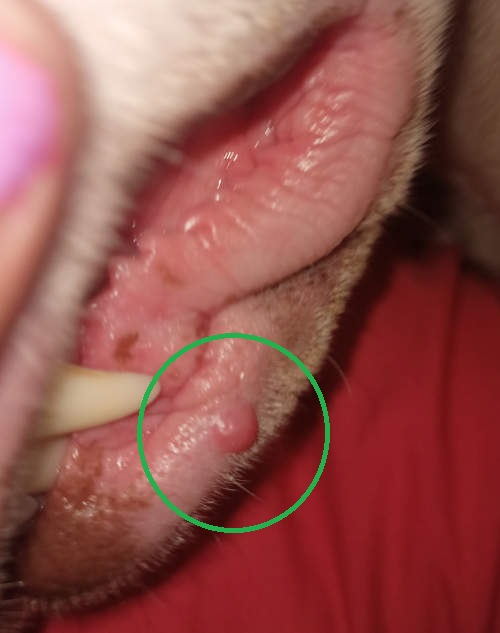
If the bump or lump has been present for more than a week and is not resolving, your vet may consider sampling it, to rule out a more serious condition such as cancer. Owners can bathe these lesions at home with cotton wool and salt water, to help prevent infection, and they should resolve quickly.
Related post: pictures of common bumps and lumps on dogs.
Is a new bump on a dog’s lip a reason for concern?
Any new lump or bump on a lip, especially one that is rapidly growing or has been present for over two weeks, is something to be taken seriously. Lumps or bumps on older dogs, or on dogs who have had cancer in the past, should be assessed promptly. The lumps we worry about most are those that grow quickly, ulcerate on the surface or bleed.
On the other hand, we tend to be less concerned about growths that are slowly evolving. Benign skin tags and warts have a specific ‘fleshy’ appearance, when compared to more sinister lesions. In any case, we recommend showing the lump to your veterinarian.
Additionally, if your dog is young, the chances of a new lip lump being benign (non-cancerous) are very high.
How long should you wait before seeing your vet?
It is normally advised to wait 1-2 weeks after first noticing a lump on the lip, especially if the dog is young and showing no signs of discomfort. However, if the lump has not resolved in this time, it is best to have it examined by a veterinary professional. Here are five signs you should book a vet visit ASAP:
- The lump has been present for two weeks and is not reducing in size
- The lump is bleeding or infected
- Your dog is bothered by the lump or seems itchy or sore
- Your dog also has a skin disease
- Your dog is elderly or has a history of cancer
Confirming an accurate diagnosis can cost $150 to $600
It is often not possible to accurately diagnose lumps and bumps from their appearance. Your veterinarian will likely advise sampling the lump and sending the cells to a lab for analysis.
The cost of this will vary depending on the clinic and which sort of biopsy procedure is used. Simple FNAs cost about $150-300, while biopsies done under anesthetic may cost $400-600. Learn more.
What the color of a lip bump can tell you (pink, red and white bumps)
A bump on a dog’s lip can be an array of different things, and sometimes the color of the lump will provide some clues.
1. Pink spot on dog’s lip
A pink or flesh-colored spot, especially those that look like little ‘brains,’ commonly appear on older dogs. In my veterinary practice, I often see them on white breeds, including Maltese and Bichon Frise.

Lesions like this can be skin tags and warts. We typically see ‘old age warts’ in senior dogs, as their immune system is weakened, and they are less able to prevent these growths from appearing. Once a dog has one, they generally develop more and more as they get older.
Of course, a pink bump on your dog’s lip could be other things too. The color is not a definitive way of telling us what the lump is. Some cancers, including mast cell tumors and carcinomas, can be pink or red. Learn more and view pictures with my article on: Pink or Red Spots on a Dog’s Lips.
2. Red bump on dog’s lip
If your dog is young and they develop a smooth red lump just beside their lip, this may well be a histiocytoma. These growths affect dogs that are less than six years of age. Oftentimes, a histiocytoma will disappear within a few months, without us having to intervene.
Even in young dogs, however, we cannot be sure a growth is a histiocytoma just from the appearance. Cancerous lesions can look similar, so your vet might suggest a fine needle aspirate (FNA) to confirm the suspected diagnosis.
If your dog has had a red bump for just a few days, we should also consider other eventualities. For example, maybe they managed to bite their lip and there is now a little blood blister. Or perhaps they’ve been stung by an insect. Lesions like this tend to resolve within the week.
Read our article about: Pink or Red Spots on a Dog’s Lips.
3. White bump on dog’s lip
Less commonly, we might find that our dogs have a white spot on their lip. Some fleshy white growths will turn out to be papillomas (warts). Young dogs can develop papillomas on the outside and inside of their mouth, if they have been exposed to another dog with warts. These contagious growths cannot be passed on to humans.

The majority of warts in young dogs will resolve within a few months and are not treated. In some unlucky individuals, the warts may proliferate and cause issues with chronic infections and difficulty eating. Your vet may consider surgical removal or a “recombinant vaccine” whereby the DNA of the papilloma vaccine is injected into the dog, causing them to mount a more effective immune response. Learn more: white spots or bumps on dogs’ lips.
4. Green or yellow spot on dog’s lip
If you’ve noticed a green or yellow bump, you may be dealing with pustules. This is a little skin blister that is caused by a bacterial skin infection. Any breed can develop these, but those prone to allergies, like the Frenchie and British Bulldog, would be more predisposed. We can see pustules in those with ‘canine acne.’ Learn more about pustules.
Disclaimer: This website's content is not a substitute for veterinary care. Always consult with your veterinarian for healthcare decisions. Read More.



My pupper has a bump on her lip. it is not on the outer lip but a little more of the middle lip. I noticed that for a while (4-8 weeks i think) she was periodically itching and scratching that side of her face and I assumed it was the outside of her ear being itchy or dusty, but for the past week i’ve noticed her scratching more on her lip rather than the rest of her face. I examined it and found the bump, but on the bump i found two darker coloured spots in the center of the lip. The bump itself is a fleshy colour and the two darker spots are dark grey with green tint. I wanted to ask if you’ve seen or heard about anything like what I’ve described and if yes if you could email me some resources to learn more about wtf is going on. Thanks.
Hi Eliza and thanks for your comment. It is hard to provide specific advice without knowing your dog’s age and breed and without seeing the lesion.
Darker areas can be scabs or areas of heavy pigment.
If your dog is a puppy, I’d suspect an oral papilloma or wart. These are really common in those less than 1. Sometimes they become infected and this can lead to itchiness and ooze. In this case, a course of antibiotics is often needed.
In short nosed breeds (like Bulldogs) oral lesions like this are often epuli, which are benign gum growths. Again, if showing signs of infection, a vet check is important. As well as antibiotics, we sometimes issue a medicated mouth wash.
For older dogs, we are sometimes dealing with cancerous lesions or tooth root abscesses. A vet visit is important so we can examine your dog and her mouth. We may biopsy the lump if concerned, and some would be removed surgically.
As she is rubbing, try to prevent this by using a buster collar.
If tolerated, we can bathe the lesion with very dilute Hibiscrub or salt water, to minimise itch and infection.
“The information on this website is not a substitute for in-person veterinary care. Always seek advice from your veterinarian if you have concerns about your pet’s medical condition.”
Hi
My 7 month old Bearded Collie developed a lump inside his lip about 8 weeks ago
He’s had Onsio tablets and it did help but it’s not gone.
Vets want to do a biopsy
The lump is the same colour pink as the inside of his mouth.
It came up as he started losing the baby teeth.
Hi there and thanks for your question! At his age, we’d be wondering about e.g. a papilloma (wart), epulis, or cyst. A cancer would be very uncommon at this age. Certainly, a biopsy is the next sensible step if your vet is not sure what it is and it has not resolved with time and therapy.
The biopsy can help guide your vet further. They may take a wait and see approach if it is a benign growth such as a wart, or they may wish to remove it.
“The information on this website is not a substitute for in-person veterinary care. Always seek advice from your veterinarian if you have concerns about your pet’s medical condition.”